Benchmarking Insights On Older Adults
The League of American Bicyclists is dedicated to building a Bicycle Friendly America for everyone. As part of working with the CDC’s Active People, Healthy Nation initiative to get 27 million people more physically active the Benchmarking Project brings public data to monitor progress on bicycling and walking in America. By partnering with AARP’s Livable Communities program, the League is excited to share insights on bicycling and walking by older adults and connect those insights to our ongoing efforts to build a Bicycle Friendly America for everyone.
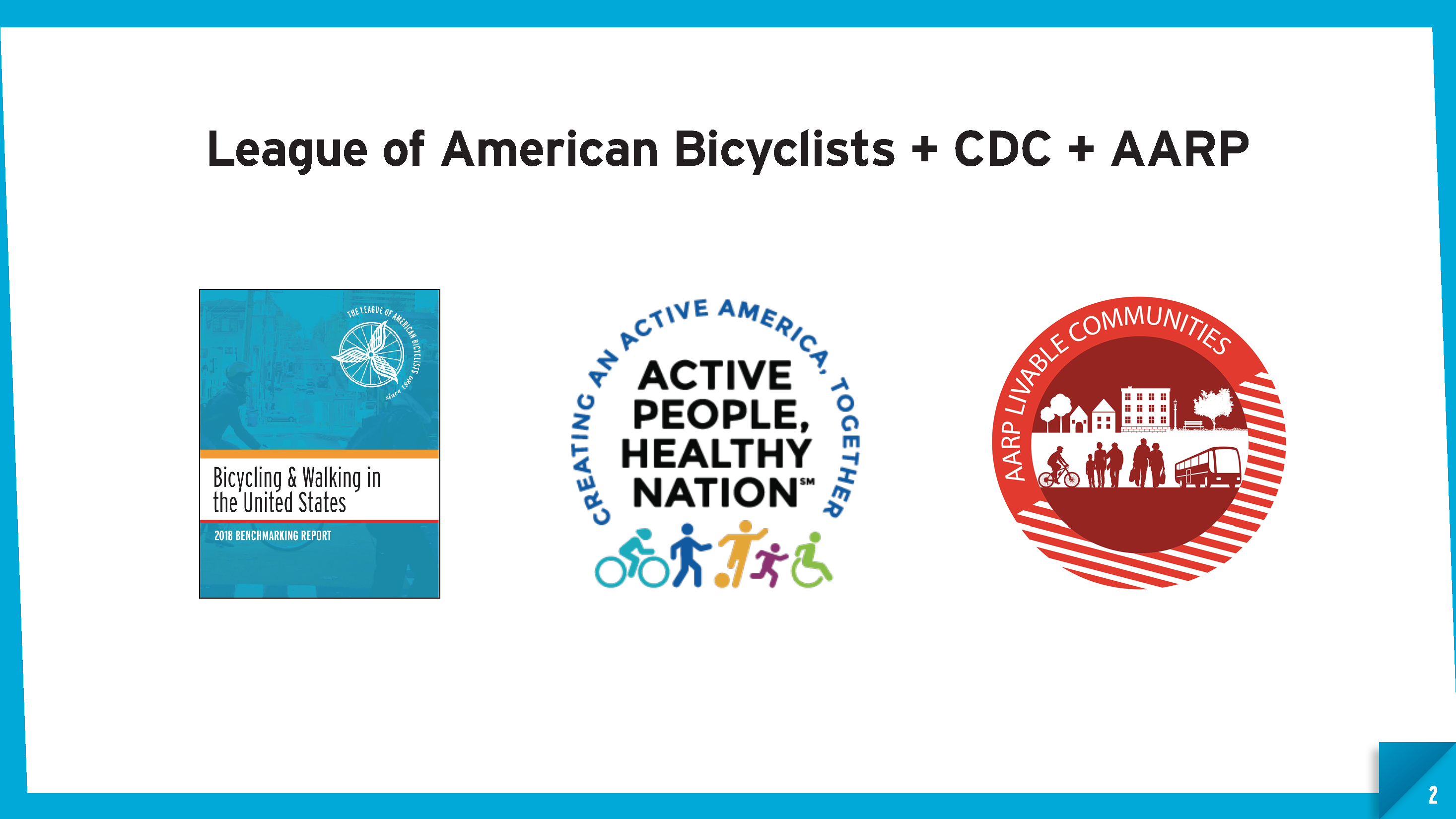
This post presents the data from our webinar with AARP Livable Communities.
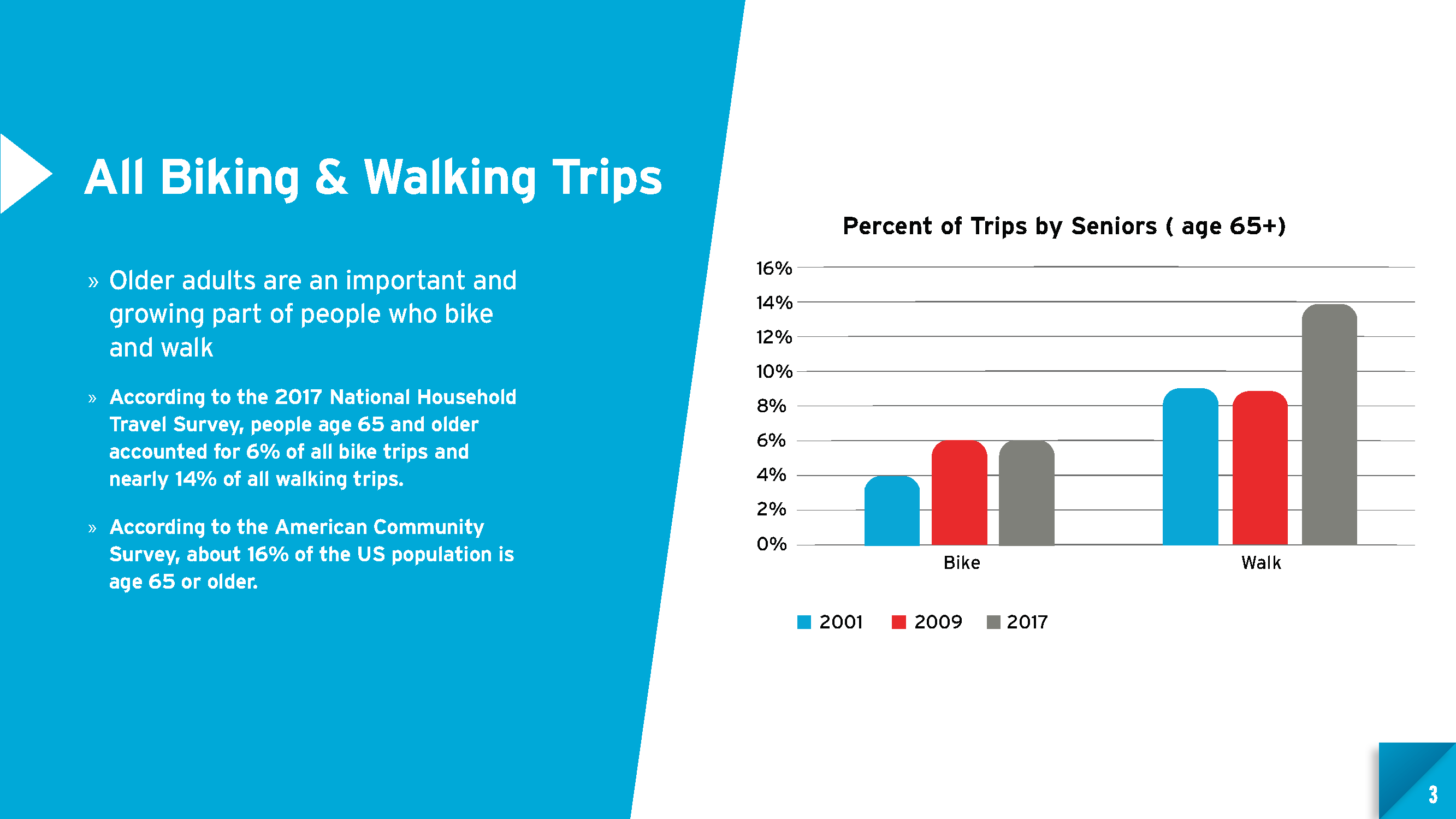
In the 2018 Benchmarking Report on Bicycling and Walking, data from the 2017 National Household Travel Survey showed that there was a statistically significant increase in the percentage of walking trips by people age 65 and older. At the same time, there was no increase in the percentage of bicycling trips by people age 65 and older. In both cases, people age 65 and older represented a smaller percentage of bicycling and walking trips than their percentage of the overall population, where they make up about 16% of the US population.
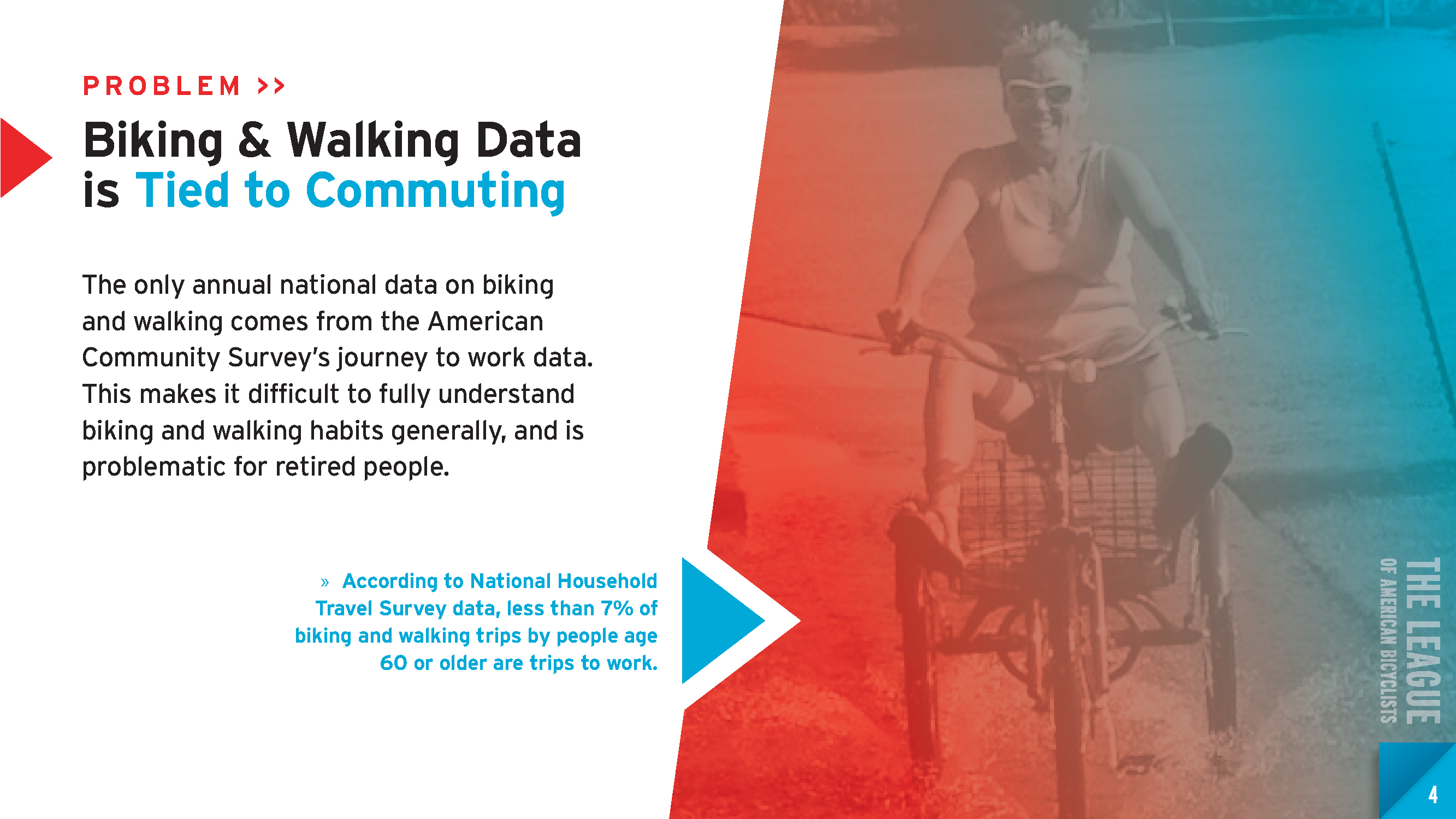
A major issue with monitoring the physical activity of older adults, and bicycling and walking generally, is that the most consistent public data available nationwide comes from the Census Bureau’s American Community Survey’s journey to work data. This is an issue for all bicycling and walking monitoring, as the journey to work is only a limited percentage of all bicycling and walking trips. For older adults, this issue is compounded as older adults retire from work and disappear from the only nationwide annual data source for bicycling and walking. It is difficult to monitor the level of bicycling and walking by older adults based on a data source that represents less than 7% of bicycling and walking trips by people age 65 and older.
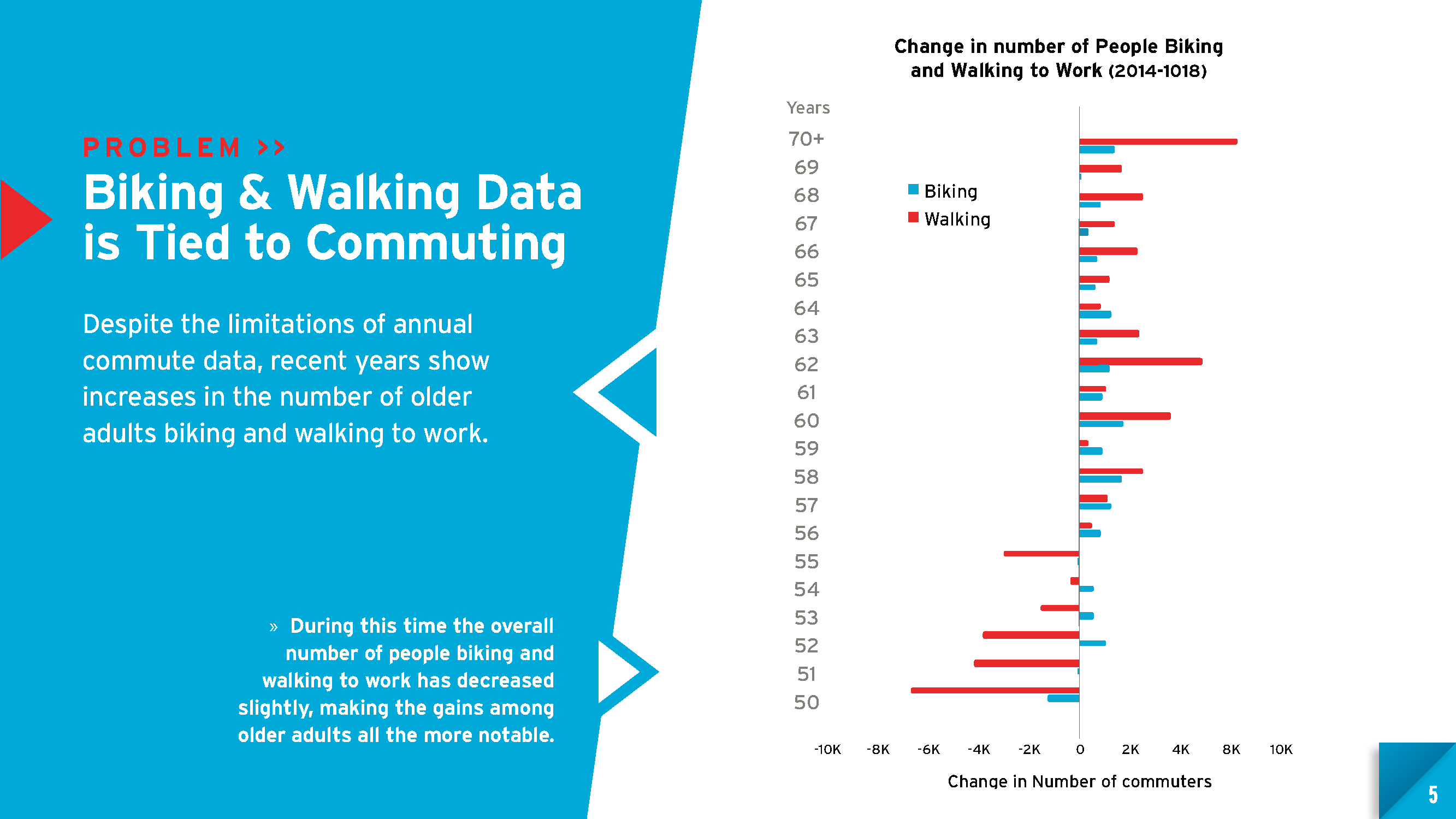
Despite the limitations of the American Community Survey’s journey to work data, recent years show increases in the number of older adults bicycling and walking to work. The chart above shows a comparison of 5-year estimates from 2014 and 2018 for the number of people biking and walking to work for ages 50 and older. For all ages over 55, the number of people biking and walking to work shows an increase. This is even more notable since the overall number of people biking and walking to work declined between those 5-year periods.
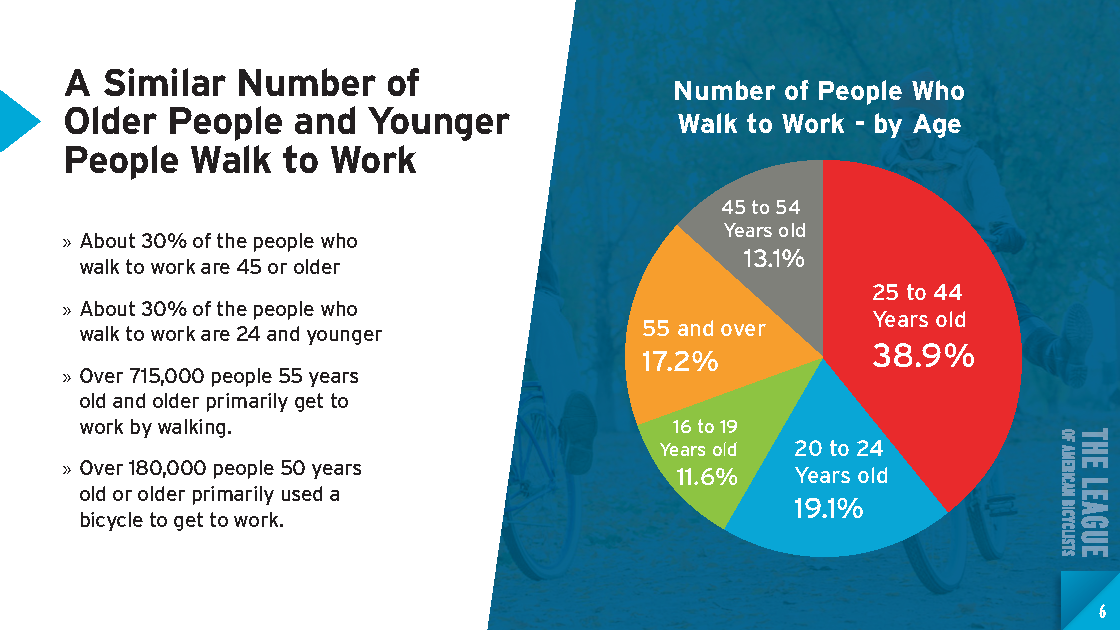
Commuter data shows us that older adults, even if less likely to be captured in the data, are a very important group for bicycling and walking to work. Together, nearly one million people age 55 and older primarily get to work by biking and walking.

Commuter data shows that older adults are likely to continue to be an important part of people biking and walking to work. Based on 5-year estimates, from 2014 to 2018 the number of people age 65 or older biking to work increased by 29% and the number walking to work increased by 11%. Data on the rate of walking to work shows that people 65 and older are more likely to use walking as their primary mode of transportation to work than people age 45 to 64.

While the only nationwide annual data on bicycling and walking comes from the journey to work, comprehensive data on all trips from the 2017 National Household Travel Survey shows that the journey to work is a small percentage of trips for people age 65 or older. The most common trip type for all ages is a trip to or from home. Trips for social and recreation purposes and for shopping and errands are very important for older adults, with people age 65 or older having the highest percentage of trips for shopping and errands of any age group.
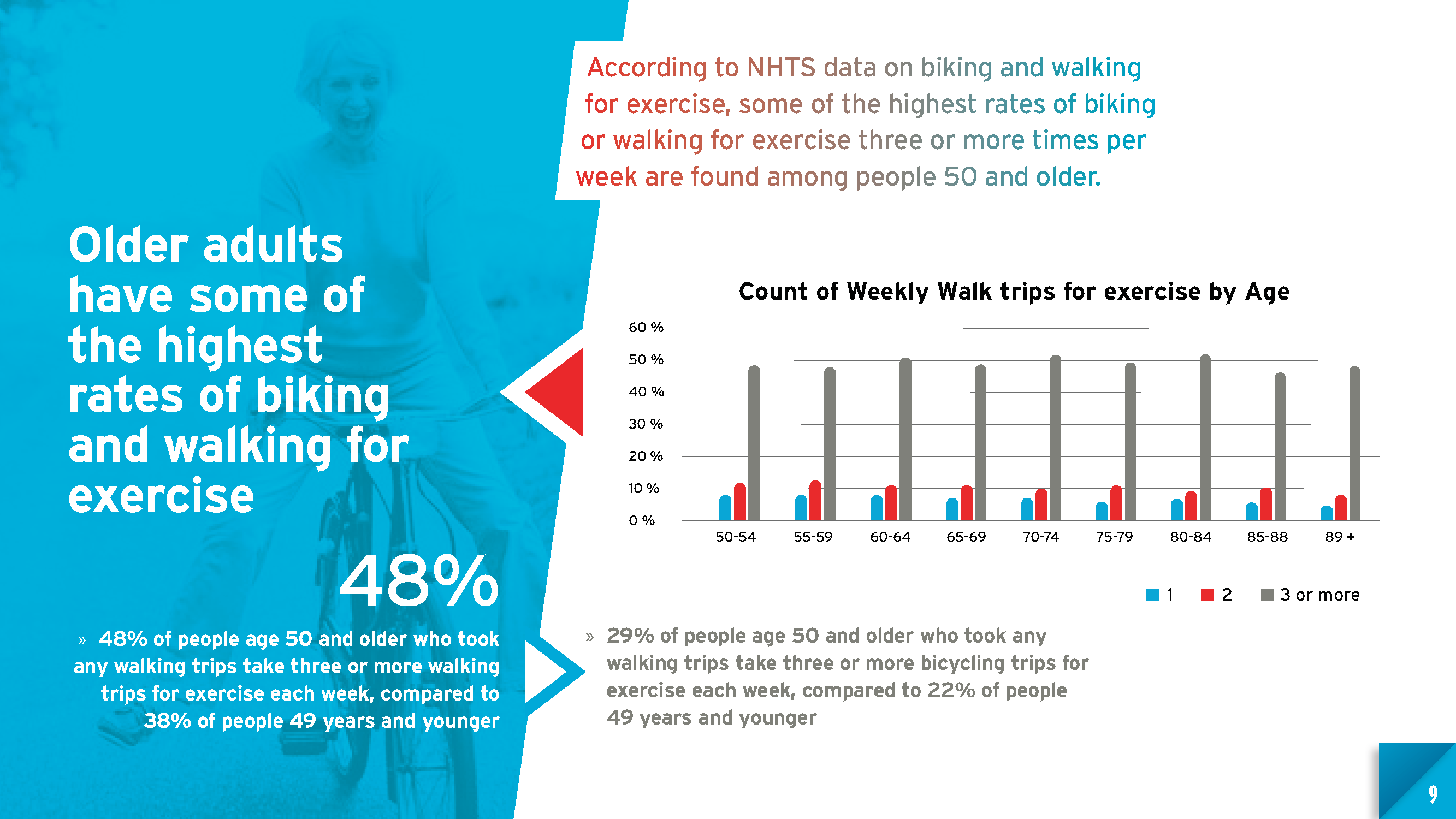
Data from the National Household Travel Survey provides insights that are not available with journey to work data. The downside to the National Household Travel Survey is that it is only published about once a decade and the survey methodology changes over time so that comparisons between surveys can be difficult.
For the goals of the League of American Bicyclists and Active People, Healthy Nation it is great that the National Household Travel Survey includes data on bicycling and walking for exercise specifically. The data on bicycling and walking for exercise above is from people who report any walking and bicycling. While the data does not include the length of each trip for exercise, the CDC’s Physical Activity Guidelines recommend that each person get 150 minutes of moderate cardiovascular physical activity each week. The data from the National Household Travel Survey shows that bicycling and walking are very common forms of exercise and that older adults are more likely to take three or more trips for exercise each week.

One great thing to see was that the data from the National Household Travel Survey on bicycling trips for exercise by older adults was consistent with the 50+ Cycling Survey conducted by Carol Kachadoorian, and supported by AARP. For the National Household Travel Survey the number of respondents who are reporting data on bicycling for exercise within older age groups is fairly small, making this consistency an important indicator that the trend of more bicycling trips for exercise among older adults who bike is valid.
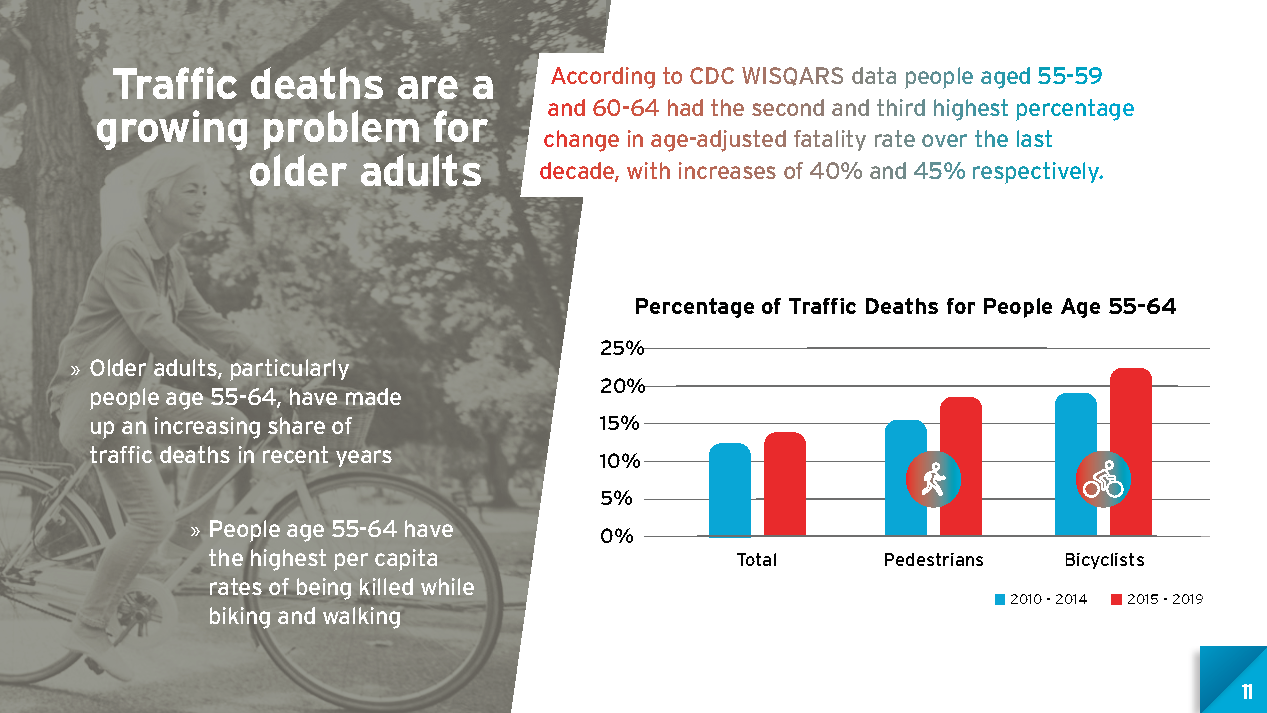
Among the many benefits of physical activity are a lower risk of coronary heart disease, stroke, high blood pressure, high cholesterol or triglycerides, type 2 diabetes, colon cancer, and breast cancer. Unfortunately, while bicycling and walking are great ways to get physical activity and very common ways to get physical activity, particularly for older adults, the last decade has seen increased traffic violence for people biking and walking. Both bicyclist and pedestrian deaths reached 30-year highs in 2018 after a decade of sustained increases in traffic violence.
Data from the National Highway Traffic Safety Administration and the CDC’s WISQARS data show that older adults have been disproportionately affected by recent increases in traffic violence for people biking and walking. CDC’s WISQARS data accounts for the changes in the age of the US population, showing that the increase in older adults killed while biking and walking is not simply a byproduct of an aging population.
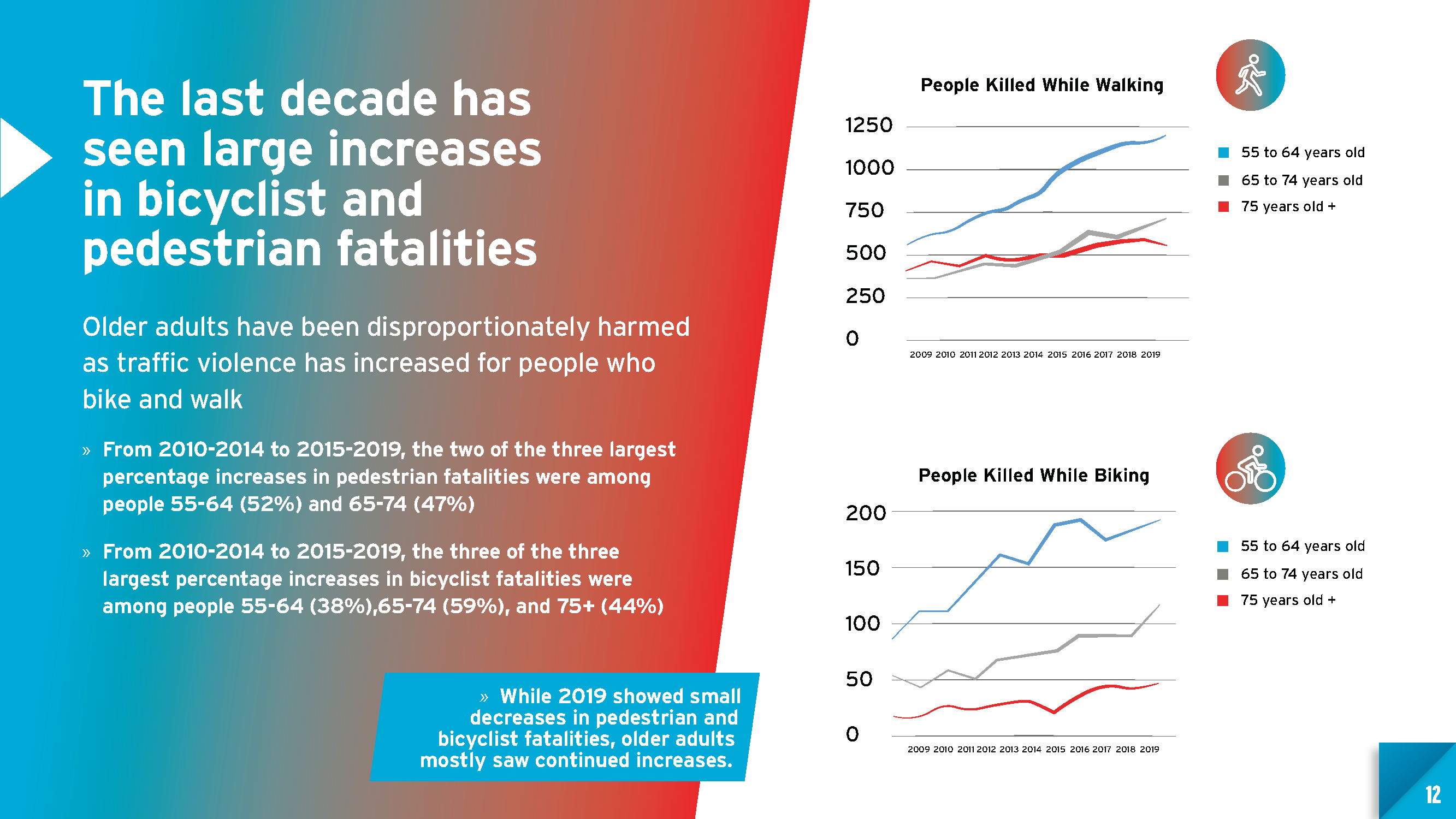
While 2019 data from the National Highway Traffic Safety Administration (NHTSA) shows small decreases in pedestrian and bicyclist fatalities, older adults mostly saw continued increases. Over the last decade, older adults have seen many of the largest percentage increases for bicyclist and pedestrian deaths among age groups reported by NHTSA.
Historically, in the 1960s when NHTSA was formed, children and youth were the most over-represented age groups in bicyclist and pedestrian fatalities. Since the 1960s there has been a sharp decline in children and youth bicycling and walking, perhaps seen most starkly in decreased rates of biking and walking to school. With less bicycling and walking by children and youth there has been a large decline in children and youth being killed while biking and walking. Now, many of the most over-represented age groups are among older adults.
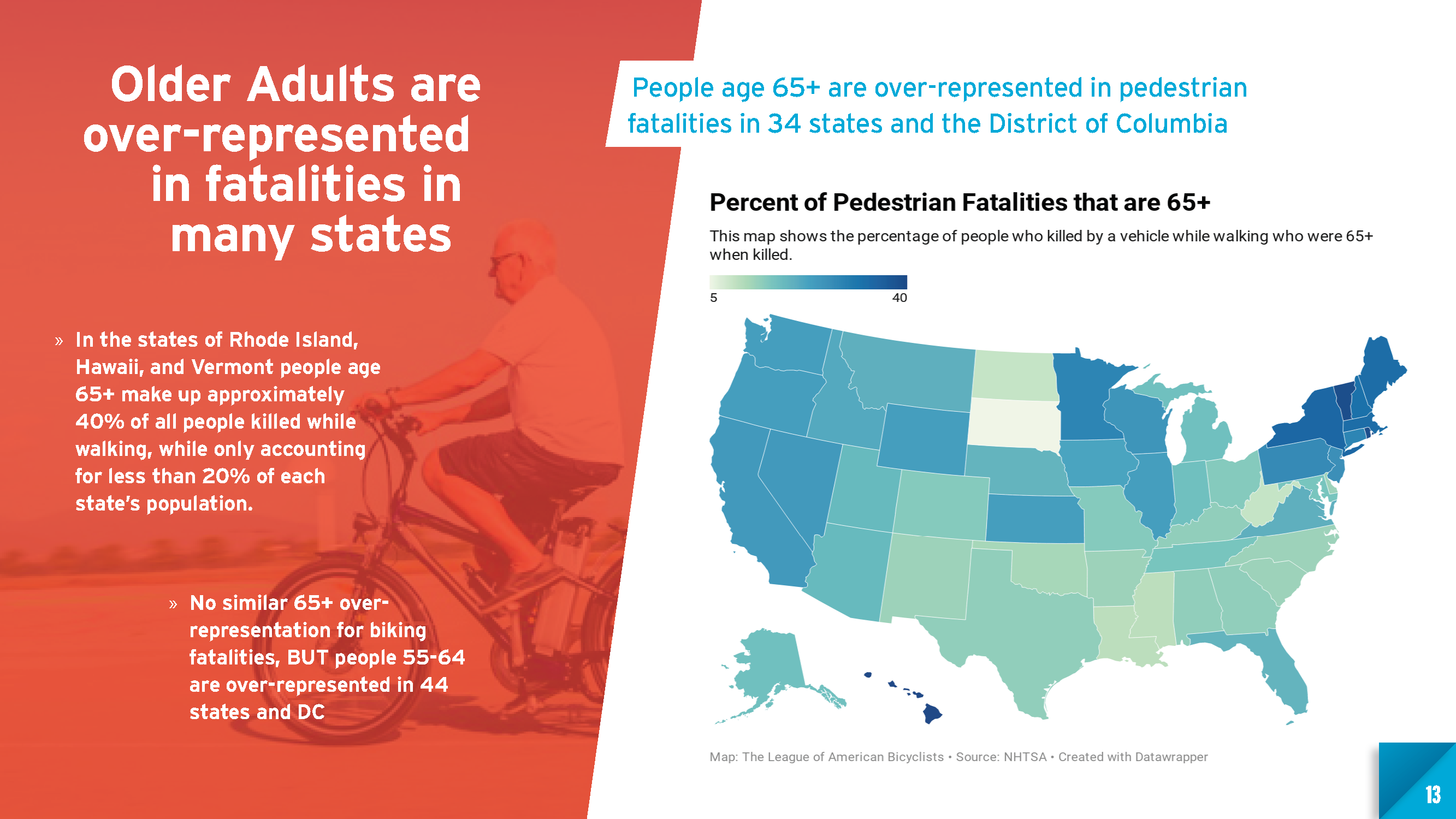
The over-representation of older adults among bicyclist and pedestrian fatalities nationally can also be seen at the state level. People age 65 and older are over-represented among pedestrian fatalities in 34 states and the District of Columbia. People age 55 to 64 are over-represented among bicyclist fatalities in 44 states and the District of Columbia.

Federal transportation funding requires each state to create a Strategic Highway Safety Plan as a condition for receiving Highway Safety Improvement Program funds. A Strategic Highway Safety Plan is coordinated with each state’s Highway Safety Plan, which directs funds for NHTSA’s Highway Safety Grant programs. Due to this coordination, it is normal for a Strategic Highway Safety Plan to not just include infrastructure investments, but also to include education and enforcement activities.
Despite older adults being over-represented in bicyclist and pedestrian fatalities as an age group, very few states explicitly identified strategies to improve safety for older people biking and walking. It is fairly common for states to identify strategies for older drivers, sometimes including changing roadway designs to make them safer for older drivers. The most common safety strategy identified by states for older driver safety is increased education efforts, representing more than one-third of all reported strategies. Only four states out of the 31 that identified older adults for a safety emphasis discussed the safety needs of older people walking.
The safety of people biking and walking is identified as an emphasis in 38 states and the District of Columbia in Strategic Highway Safety Plans. States were most likely to identify strategies to improve engineering in their Strategic Highway Safety Plans for the safety of people biking and walking. This is great as data shows that infrastructure is the most effective investment to make people biking and walking safe, and safer infrastructure can also encourage more people to bike and walk.
Although an emphasis on the safety of people biking and walking is common, it is not common for states to identify strategies focused on older adults biking and walking. Only three states – Missouri, Pennsylvania, and Tennessee – specifically discussed strategies for the safety of older people walking. No state specifically discussed strategies for the safety of older people bicycling. This oversight can also be seen in the FHWA’s “Handbook for Designing Roadways for the Aging Population” which barely mentions the needs of older people walking and has no guidance on the needs of older people bicycling.
Federal transportation policies tend to put state Departments of Transportation at the center of funding and planning processes. Data on traffic fatalities also suggests that state Departments of Transportation need to be at the center of safety improvements. Roadway ownership was first reported for traffic fatalities by NHTSA in 2015. So far, that reported data shows that state owned roadways are where most people are killed by traffic violence. For people biking and walking, city or municipally owned roadways are also important to address, but state owned roadways are where most bicyclist and pedestrian fatalities occur.
State owned roadways may be more likely to be roadways that connect places within a state or between states. This may make those roadways more likely to have “heavy traffic with too many cars” which is a common reason that people of all ages, but particularly older adults give for why they do not bike or walk more. If state Departments of Transportation invested to improve safety for people who bike and walk then it might be possible for them to address both the high level of traffic fatalities on state owned roadways and the concerns of people who might bike and walk more, including older adults. A lack of street lighting was also a common reason given for not biking and walking more.

The CDC’s Active People, Healthy Nation initiative places an emphasis on creating Activity-Friendly Routes to Everyday Destinations. This comes from the understanding that people need places to bike and walk and they need places to bike and walk to. Data from the National Household Travel Survey suggests that older adults are more affected by a lack of safe places to bike and walk than a lack of places to bike and walk to. This makes sense given the importance of biking and walking trips for exercise for older adults. Exercise trips do not necessarily need destinations if the trip can be done on safe infrastructure. States and cities should act to create more paths, trails, and sidewalks – and make sure they are in great condition – to help more people be physically active.
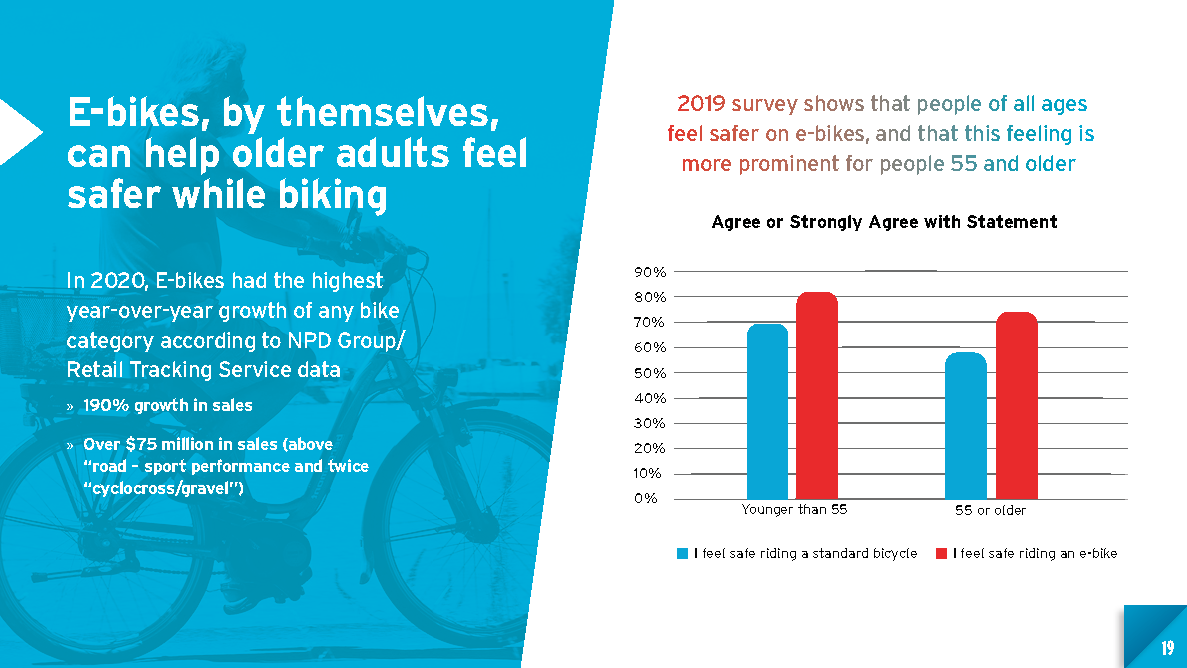
One way that older adults are finding they can increase their physical activity, and increase their feeling of safety while bicycling, is by using an e-bike. An e-bike, or electrically-assisted bicycle, typically has a top speed of 20 mph and can provide power assistance due to pedaling or a throttle. A 2019 survey by Portland State University found that people 55 and older felt more safe when riding an e-bike and that increased feeling of safety for larger for older adults than for other age groups. Sales of e-bikes have grown at a rapid rate in recent years, with 190% growth in sales in 2020 alone.

The insights collected here show that bicycling and walking are critically important for the physical activity and health of older adults. Over the last decade, as bicyclist and pedestrian fatalities have increased older adults have disproportionately felt the brunt of that traffic violence and so far there have been few state or federal efforts to specifically address the needs of older people biking and walking. While data is limited on bicycling and walking among older adults, we know that there is a strong potential to increase bicycling and walking, and physical activity, through better bike lanes, paths, and sidewalks; better street and path lighting; and the encouragement of e-bikes. By using these insights to illuminate these issues we hope that more places will develop data and respond to the needs of older adults biking and walking.